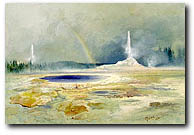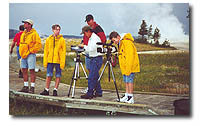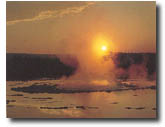%20of%20geyserbar.JPG)
Yellowstone
is a country teeming with an estimated 10,000 thermal features. Of these
only three percent are geysers. The rest are steaming pools, hissing
fumaroles, bubbling mud pots or warm seeps. Most of Yellowstone's geysers
are small, and sputter and splash, barely reaching ten feet in height.
Only six grand geysers, those which erupt 100 feet or higher on a predictable
daily basis, exist. Old Faithful, the most famous of these, erupts once
approximately every 45 to 90 minutes.
 Beneath
the thermal basins lie the mechanisms which control these features.
The most essential element is magma-underground molten rock. No one
knows exactly how close to the surface this body of magma lies. Geologists
believe the earth's crust is less than 40 miles thick in Yellowstone
compared to 90 miles under most other land areas. Intruded into this
thinner crust. like bubbles, are magma intrusions-also known as plutons.
These intrusions are typically at a depth of four to ten miles. In most
regions of the earth's crust the temperature gradient averages about
1.4°F per 100 feet. A test well drilled at Norris Geyser Basin during
the late 1920s revealed a temperature of 401 °F at a depth of 265 feet.
Thus the ground temperature gradient at this point is an astonishing
123°F per 100 feet. Beneath
the thermal basins lie the mechanisms which control these features.
The most essential element is magma-underground molten rock. No one
knows exactly how close to the surface this body of magma lies. Geologists
believe the earth's crust is less than 40 miles thick in Yellowstone
compared to 90 miles under most other land areas. Intruded into this
thinner crust. like bubbles, are magma intrusions-also known as plutons.
These intrusions are typically at a depth of four to ten miles. In most
regions of the earth's crust the temperature gradient averages about
1.4°F per 100 feet. A test well drilled at Norris Geyser Basin during
the late 1920s revealed a temperature of 401 °F at a depth of 265 feet.
Thus the ground temperature gradient at this point is an astonishing
123°F per 100 feet.
|
"The Wonders
of Yellowstone"
- 98 Minutes
-
~Telly Award Winner for Nature
and Wildlife~
Two years in the making
and just released, "The Wonders of Yellowstone" video
has been highly requested, produced in DVD format and is now available.
Take a complete tour of Yellowstone National Park as our Narrator
Cathy Coan guides you to all the wonders of the park including
all the geyser basins, wildlife, waterfalls and much more.
We previously sold
travel packets but these packets, maps and trail guides are all
available at the park for free or minimal charge.
More
Info or Order Online |
A transition zone exists between the
hot molten magma and the crust. This pliable layer of partially molten
crystalline rock is close to its melting point. This zone heats water
which has seeped down from the surface. Water filters through fissures,
cracks, and porous rock and eventually circulates to a depth of about
two miles. There it becomes heated by molten crystalline rock to a temperature
above its surface boiling point. But it does not boil because of the
pressure in the underground network. As the superheated waterworks its
way up through the subterranean chambers and conduits, pressure on it
is relieved. The naturally formed plumbing system traps superheated
water before it reaches the surface and cools. Near the surface, when
pressure is suddenly released, boiling explosions occur forming steam.
The sudden expansion in volume then triggers a series of reactions leading
to a geyser eruption. The frequency or interval of an eruption depends
on how much energy is spent and how quickly a geyser recovers. Thus
Geysers vary in their interval, duration, and volume of discharge. These
variables also determine the opening or vent surrounding a geyser. Two
types of mineral deposits form around geyser vents. Cone-type formations
have formed around Old Faithful, Castle, Beehive, and Lone Star geysers.
Fountain-type formations, which contain a pool of water over their vents,
have formed around Great Fountain and Grand geysers.
Yellowstone's thermal features could
not exist without 
the presence of three essential elements. First there
must be a heat source. This heat source, a magma intrusion, typically
at a depth of four to ten miles, heats the surrounding crystalline rock
by conduction. The second essential element is water, which falls as
rain and snow and percolates to a depth of two to three miles following
cracks and fissures. The water collects in a porous reservoir where
it becomes heated by the magma intrusion.The superheated water wants
to expand. Because of the depth and pressure the water begins to rise
and the heated water moves through the third essential element, rhyolite,
asilica-bearing rock, hard and strong enough to withstand heat and pressure.
As the thermal water reaches the surface pressure is relieved and the
water emerges as either a geyser, hot spring, fumarole or mud pot.
Mineral-laden water, rich in silica,
deposits on the lining of subterranean chambers and conduits and forms
a natural plumbing system which is located within 200 feet of the surface.
A geyser must have a nearly vertical underground tube that connects
with side chambers or porous rock, where water can accumulate and act
as a reservoir. A geyser must also have a constriction or narrowing
near the surface in the natural plumbing system. This constriction acts
as a check valve, like the workings of a pressure cooker. In some twisted
networks, water can cool substantially; lacking a constriction, water
oozes from the vent as a hot spring. Water does not reach the surface
in a fumarole. Only steam and gases echo up its throat, causing it to
hiss and roar.
 Geysers
maintain a delicate balance between water and steam. A slight change
can upset an eruption. A pre-eruptive
splash may trigger a major eruption or cause a delay. Man can also have
this same effect. Coins, sticks, stones, handkerchiefs, or soap thrown
into a Yellowstone thermal feature can cause it to erupt prematurely,
or more likely, cause it to clog, wither, and die. Earthquakes also
play a major role in upsetting the delicate balance of geysers. Near
midnight on August 17, 1959 an earthquake, epicentered twelve miles
north of West Yellowstone near Hebgen Lake, shook eight surrounding
states. It measured 7.1 on the Richter scale, formed a twenty foot displacement,
and carved a slab from a mountain side which dammed the Madison River.
In Yellowstone thermal activity increased. Geysers began to erupt, some
with new vigor. Dormant geysers awoke and hot pools surged with excess
water. The earthquake also caused some geysers to decrease in activity
and shut others off completely. Geysers
maintain a delicate balance between water and steam. A slight change
can upset an eruption. A pre-eruptive
splash may trigger a major eruption or cause a delay. Man can also have
this same effect. Coins, sticks, stones, handkerchiefs, or soap thrown
into a Yellowstone thermal feature can cause it to erupt prematurely,
or more likely, cause it to clog, wither, and die. Earthquakes also
play a major role in upsetting the delicate balance of geysers. Near
midnight on August 17, 1959 an earthquake, epicentered twelve miles
north of West Yellowstone near Hebgen Lake, shook eight surrounding
states. It measured 7.1 on the Richter scale, formed a twenty foot displacement,
and carved a slab from a mountain side which dammed the Madison River.
In Yellowstone thermal activity increased. Geysers began to erupt, some
with new vigor. Dormant geysers awoke and hot pools surged with excess
water. The earthquake also caused some geysers to decrease in activity
and shut others off completely.
The thermal features of Yellowstone could
not exist without the rock types found beneath the thermal basins. Hard
minerals and rocks are needed to withstand intense heat and pressure.
Except for Mammoth Hot Springs, most superheated geyser water passes
through rhyolite and volcanic ash and tuff. These rocks consist mainly
of silica, a hard mineral found in quartz and glass. When superheated
water passes through these rocks it becomes laden with silica and carried
to the surface. Some of the silica deposits on the thermal features
underground plumbing, thus lining and hardening the conduits. The remainder
surfaces and deposits externally. During an eruption a geyser will splash
the mineral-laden water around its vent. Given ample time between eruptions,
the water will evaporate, and deposit silica. Silica forms sinter, or
geyserite, the notable rock formation built around these features. Sinter
can form delicate scalloped edges on hot pools and elaborate cones on
geysers. The amount of deposit surrounding a feature does not always
determine its age. Drilling and core samples made in the Upper Geyser
Basin revealed a sinter layer nearly 20 feet thick. Deposition varies
and depends on the amount of silica brought to the surface and this
is not always consistent. A large sinter mound does not always mean
an old thermal feature. But most sinter accumulation is only a minute
fraction of an inch annually. Waters flowing from hydrothermal springs
contain several dissolved minerals and gases. Waters from these springs
are classified into four groups: alkali chloride; acid sulfate; acid
sulfate-chloride; and bicarbonate. These minerals in turn determine
the water's pH as acidic, neutral or alkaline. Most geyser basins are
either acidic or alkaline, and in some, like Norris, acidic and alkaline
springs flow side by side. Some of the thermal features emit strong
or obnoxious smells and even deadly odoriess gases. These gases, released
at the surface after the pressure lowers, include carbon dioxide, hydrogen
sulfide, methane, hydrogen, oxygen, nitrogen, ammonia, argon, radon,
as well as other noble gases such as helium, neon, krypton, and xenon.
Travertine is the mineral formation responsible for the famous Mammoth
Terraces. The mineral-calcium carbonate-is carried to the surface like
sinter, but dissolves in heated water and precipitates or deposits into
rinds or terraces as the water cools and evaporates. The mineral is
softer than sinter and does not form the hard concrete-like encrustations
and thus cannot withstand the intense heat and pressure needed to form
a geyser's natural plumbing system. Calcium carbonate is white when
fresh and ages to a dull gray, but in the run-off channels various colors
of algae and bacteria add their brilliance, highlighting the delicate
travertine draperies.
In Yellowstone, hot springs, pools, and
run-off channels exhibit all colors of the rainbow. Bacteria and algae
are mainly responsible for brightly colored run-off channels. Different
temperatures of water both cause and also permit differences in plant
communities and intensities of color. The run-off channel from a hot
spring, for example, is white or clear near its source. Only a few single-cell
bacteria live in this boiling water, which is 199°F at the average Yellowstone
elevation of 7,500 feet. Pure water boils at 212°F at sea level. As
the water slightly cools other forms of bacteria develop long hair-like
strands which become visible to
the naked eye. These thermophilic hot-water-loving species may be remnants
of some of the earliest life on earth. As water cools to 167°F farther
down stream, the first colorful forms of cyanobacterium (Synechococcus lividus), filamentous green nonsulfur bacterium (Chloroflexus aurantiacus)andpwpte-suHwbactenum(Chromatiun1tepidum) begin
to colonize and form laminated mats. Only the first millimeter of a
microbial mat actively grows. The top bacteria layer shades the bacteria
below and new individuals grow upon the remains of the previous
generation, thus forming a laminated mat. In colder, acidiewaterthick,
long strands of brown filamentous bacterium (Zygongonium) wave
and undulate in the flowing channels. Thus, water chemistry and temperature
determine the species present in a run-off channel. Pigments within
microorganisms are responsible for their colors. Chlorophyll produces
grass-green, carotenoids are yellow, orange or red. And all pigments
found in living cells intensify or become muted directly by the amount
of light they receive daily or seasonally.
Large hot pools also radiate with brilliant
colors ranging from deep blue to emerald green. These waters reflect
the blue color rays present in sunlight and absorb the remainder of
the color spectrum. A blue hot pool changes its mood from day to day,
depending upon the intensity of light or the amount of particulate matter
suspended in the water. Fine particles of silica or clay suspended in
the water produce a baby blue colored pool, a blue thermal pool lined
with yellow sulfur or yellow bacteria produces hues of green, forming
emerald-colored pools. Black pools are often lined with orange-colored
bacteria which coupled with blue tinted water, results in pools dark-colored
in appearance. Other plants and animals thrive among the geyser basins.
Small black ephydrid flies live on the microbial mats. They swarm on
the shallow run-off channels, feeding upon algae and bacteria, laying
their bright orange egg clusters on any small stick or rock projecting
above the mat. Their larvae burrow and feed in the microbial mat and
can tolerate temperatures up to 116°F. During winter the flies live
a precarious life in a warm zone close to the water. If the flies stray
away from this warm protective zone, the cold winter air would freeze
them in seconds. But they move up and down the run-off channels seeking
their proper temperature. In summer other perils take their toll. Large
predatory wolf spiders, dragonflies, and killdeers pray upon and eat
the small flies and their larvae.
By looking closely at the microbial mats
with the naked eye it is possible to find the tiny hot spring mite.
No larger than a pin head they are mainly visible because of their bright
vermilion color. They are structurally adapted for creeping beneath
the surface film at the water's edge and for moving in open water. Temperature
controls their distribution. When the temperature is below 113°F they
move up stream. When it is above 122°F they move down stream. This behavioral
adaptation assures the animals of nearly constant temperatures year
round. Adults are predatory upon fly larvae and nymphs are assumed to
be parasitic, but their host is not known. The hottest natural waters
that fish inhabit does not exceed 104°F, although there may be fish
able to tolerate water of 110°F for a few minutes. Fish and aquatic
animals (protozoans, rotifers, nematodes, and annelids) confront the
problems of extreme heat and also of low oxygen content, for relatively
little oxygen is dissolved in hot water. For this reason fish and arthropods
do not live in the thermal springs.
The warmth of the thermal basins does
stimulate early germination of plant life. During winter, in isolated,
protected pockets, mosses, grasses and even flowers can thrive and flower.
In early spring when run-off is high and the ground is moist, yellowmonkey
flowers line hotspring channels. By early summer, purple fringed gentians
cluster near the hot springs in moist bogs or gravelly soil. Later in
the summer when the basin soils dry, yellow star-like blossoms of stonecrop
appear on the desert-like pavement.
- Carl Schreier - A
Field Guide to Yellowstone's Geyser's
Hot Springs and Fumaroles
|

